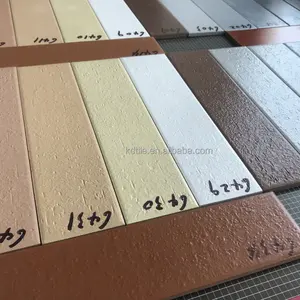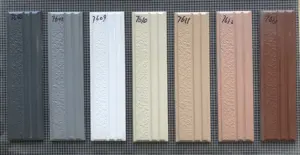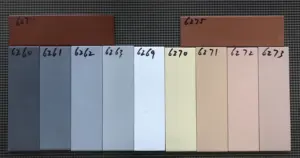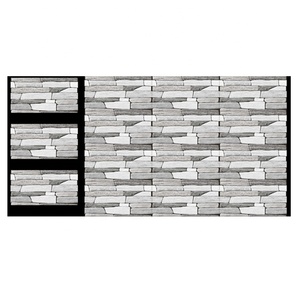(109 products available)
































































































































































































Facing bricks, also known as cheap facing bricks, are used as external walls for buildings. These bricks are durable and have an appealing aesthetic appearance. These bricks are also used in load-bearing applications. Due to their high compressive strength, facing bricks can be used in applications with high stress and load. These bricks are made of clay or molded concrete. They are used to construct buildings, pavements, and other external walls. They consist of clay, shale, concrete, or calcium silicate.
These bricks come in different colors, textures, and sizes, and are able to withstand weather elements. Cheap facing bricks are used for decorative purposes to enhance the appearance of a building. They are available in different sizes and colors and are used in non-load-bearing walls. Below are the types of cheap facing bricks:
Facing bricks have different functions and features, including the following:
Load-bearing capacity
Load-bearing bricks are used for structural walls, supporting beams, and load-bearing walls. They can carry loads from above and distribute them to the foundation. Non-load bearing bricks are used for infill walls, partitions, and decorative walls. They do not carry structural loads but provide architectural functions.
Insulation capacity
Insulation facing bricks are used for exterior walls to resist heat flow and improve energy efficiency. They have a higher R-value or lower U-value. Insulation facing bricks are suitable for cold climates. Non-insulation facing bricks are used for interior walls and have lower insulation requirements. They may have a lower R-value.
Moisture Resistance
Moisture-resistant bricks resist moisture penetration and are used in areas such as bathrooms, kitchens, and exterior walls. They include clay bricks, concrete bricks, and fly ash bricks. Non-moisture resistant bricks are used in areas where moisture is not prevalent. They may absorb moisture and deteriorate over time.
Fire Resistance
Fire-resistant bricks are used for fireplaces, chimneys, and areas exposed to high heat. They include clay fire bricks and refractory bricks. They are rated by the International Building Code based on their ability to resist flame penetration and heat transfer. The rating ranges from F0 for less than 5 hours to F3 for more than 15 hours.
Aesthetic qualities
Bricks come in different colors, textures, and sizes to offer different aesthetic qualities. They include clay bricks, concrete bricks, calcium silicate bricks, and fly ash bricks. They also include facing bricks, engineering bricks, and glazed bricks.
Durability
Bricks are durable and can last for many years with proper care and maintenance. They are resistant to wear and tear, weather elements, and pests.
Low Maintenance
Bricks require little maintenance to preserve their appearance and performance. Regular cleaning and occasional repointing are usually sufficient.
Now that we have discussed the types and uses of facing bricks, let us look at how to choose them.
Know the type of bricks
First, one should know the type of bricks, whether clay or concrete. Then, determine the purpose of the facing bricks. Are they for exterior walls, interior walls, pathways, or driveways? Each application may require a specific type.
Color, texture, and finish
Choose the color, texture, and finish of the facing bricks to ensure they will complement the design style of the building. Whether modern, traditional, or rustic, the right color and texture will enhance the visual appeal.
Structural integrity and load-bearing capacity
For facing bricks used on walls, ensure they have adequate load-bearing capacity and structural integrity. This ensures the safety and longevity of the wall or structure being built.
Quality and price
Buy quality bricks from reputable facing brick manufacturers at a cost that is within the budget. It is important to note that while choosing low-quality bricks may seem more affordable initially, it can lead to higher long-term costs due to increased maintenance and repairs.
Water absorption
Water absorption is critical when choosing facing bricks for external applications. Bricks with low water absorption are ideal for external applications as they resist freezing and thawing and prevent mold growth.
Meet local building codes
Facing bricks should meet the required local building codes and regulations. This ensures safety and legal compliance.
Consult experts
Consulting experts is a wise approach to ensure informed decision-making. Whether working with architects, engineers, or experienced contractors, seeking professional guidance will provide valuable insights tailored to specific project needs.
Q1: Are facing bricks the same as wall bricks?
A1: Facing bricks are often referred to as wall bricks, but they are not the same. According to experts, facing bricks are used to enhance the structural appeal of a wall, while wall bricks can be used for walls.
Q2: What are the types of bricks walls?
A2: There are several types of bricks for walls, including clay bricks, concrete bricks, fly ash bricks, facing bricks, fire bricks, marble bricks, and engineering bricks.
Q3: What are the qualities of good bricks?
A3: Good bricks should be hard, with a ringing sound when struck. They should be uniform in shape, size, and color. Additionally, they should absorb water quickly and have a smoke-free, firm mortar bed.
Q4: What is the importance of facing bricks?
A4: Cheap facing bricks, especially clay bricks, have a timeless appeal and provide natural texture and color. They are durable and low maintenance. They also offer design flexibility, energy efficiency, and, most importantly, increase property value.